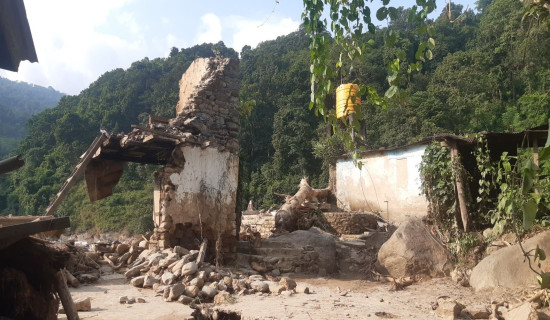- Monday, 15 December 2025
Relevance Of SEE
Very recently, around half a million students sat for their Secondary Education Examination (SEE). Although this is a large number by itself, it is quite dismal when observing the trend. The number of students taking the SEE is decreasing every year. At a time when it's crucial to retain young intellectual talent within the country, we need to discuss the relevance and effectiveness of the current system of the SEE, often referred to as the 'Iron Gate'.
Now, the glory days of the Iron Gate are long gone. Ever since the new Education Act (2016 AD), formed according to the new constitution, has been implemented, the SEE has lost its charm. Previously, the government gave the School Leaving Certificate (SLC) after Grade 10. However, after the 2016 Act, this has been pushed up to Grade 12. I believe this is for the better, considering that it motivated students to study until Grade 12 to officially complete secondary education.
The Act Relating to Compulsory and Free Education (2018) has defined ‘Secondary Education’ as the education provided in grades 9 through 12. Furthermore, in Schedule 8 of the Constitution, it is mentioned that basic and secondary education come under the jurisdiction of the local governments. However, this is not seen in practice. The SEE is conducted nationally by the National Examination Board, and the SEE transcripts are issued by the Federal Government. There is a missing link regarding the SEE.
Apart from these evident problems, a huge question looms over the very existence, relevance, and legality of the SEE. Secondary education, according to the 2018 Act, culminates after Grade 12. So, why should the Secondary Education Examination take place after Grade 10 when there are still two more years of secondary schooling left? Can the local government not take the Basic Level Examination after Grade 8 and the Secondary Education Examination after Grade 12 and subsequently provide the School Leaving Certificate? The federal government need not bother itself with such tasks. Furthermore, it can relieve the students of the unnecessary fame of the SEE that makes them subject to the extreme pressure associated with the SEE.
If the Grade 10 examination is taken as just another examination and the Grade 12 examination is seen as the culminating examination, then students need to stay at school for two more years, which is better for the country in producing skilled human capital. In my opinion, this is a better model for the Nepali education system. This is also the model of the education system as envisioned by the Constitution.
Therefore, the federal and local governments need to initiate coordination and shift the burden of secondary education. In my opinion, the education system needs to accommodate strict and impartial continuous assessment techniques where students’ promotion is subject to their regular performance in the classroom based on their assignments, discipline, punctuality, quality of work, and presentation skills, among others, in addition to a standardised test. Recently, there have been many research findings that show standardised tests put students with low resources at a disadvantage. This is the reason why US colleges are focusing more on teacher recommendation letters and extracurricular activities than SAT or ACT scores. Currently, in Nepal, internal or practical marks account for 25 per cent of the grade. However, if this can be increased, then students with low resources will not be disadvantaged.
Many, especially teachers and people from the education field, argue that discarding the SEE would allow sub-par students to come to Grades 11 and 12 and would eventually lead to their academic demise. If strict promotion criteria are set in all grades and monitored by the local government, then such a problem will not occur. Still, keeping the SEE in this current format is much more detrimental. As mentioned previously, there is an unnecessary fame associated with the SEE. Its legacy as the iron gate makes all students and parents worry about it. Students are subject to the huge expectations of many. This causes students to resort to unfair means to achieve good scores. This is not only the case for the SEE but for nearly all board exams as well. This is evident from the fact that this year, exam authorities found many phones with SEE students at exam centres with the intention of cheating. This can be stopped if the number of board exams is decreased from three (Grade 8, Grade 10, and Grade 12) to two (Grade 8 and Grade 12), and also if the modality of the exams changes in such a way that their entire result doesn’t matter on a single examination at the end of the year.
The education system of the country doesn’t fully rely on the constitution. Due to this, many questions can be raised about the education sector and the examination system. To resolve this, first and foremost, the federal government should give the burden of secondary education and examinations to local governments, as it lies within their jurisdiction. Secondly, local governments should educate students on topics of wide coverage with the help of the local syllabus. Finally, the local governments should give external ‘board’ examinations in Grade 8, as it is the final year of basic education, and Grade 12, as it is the final year of secondary education. The examinations should be conducted thoughtfully. The country needs to produce good students, not good exam-takers. If we focus only on the final exam and final result, then we will produce good exam-takers. However, if we focus on the entire year through continuous assessment, we will be able to separate good students from good exam-takers. Discourse, discussion, and research are necessary for the education sector to be reformed.
The system of education envisioned by our constitution is not that bad. If that is followed by minor adjustments and a modern system is put in place, the relevance of such board examinations will continue to flourish.
(A-levels at Rato Bangala School.)

















